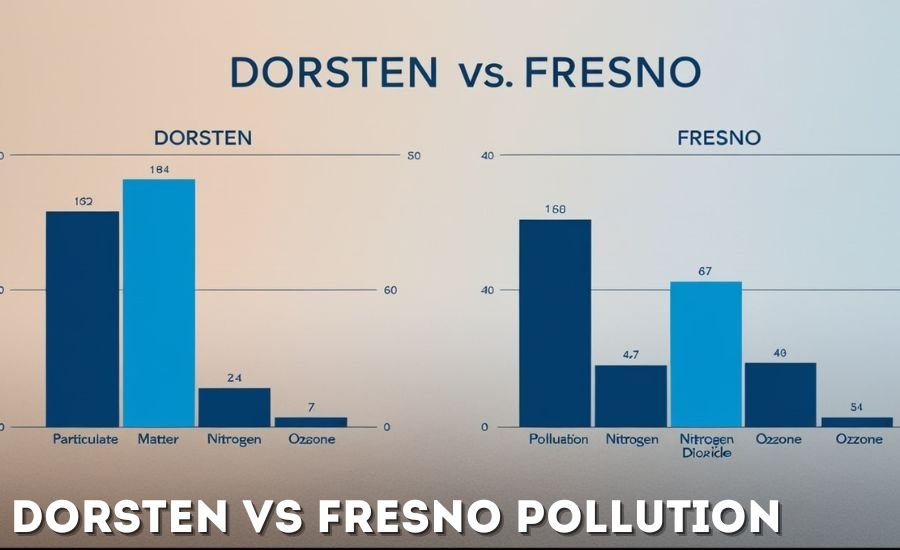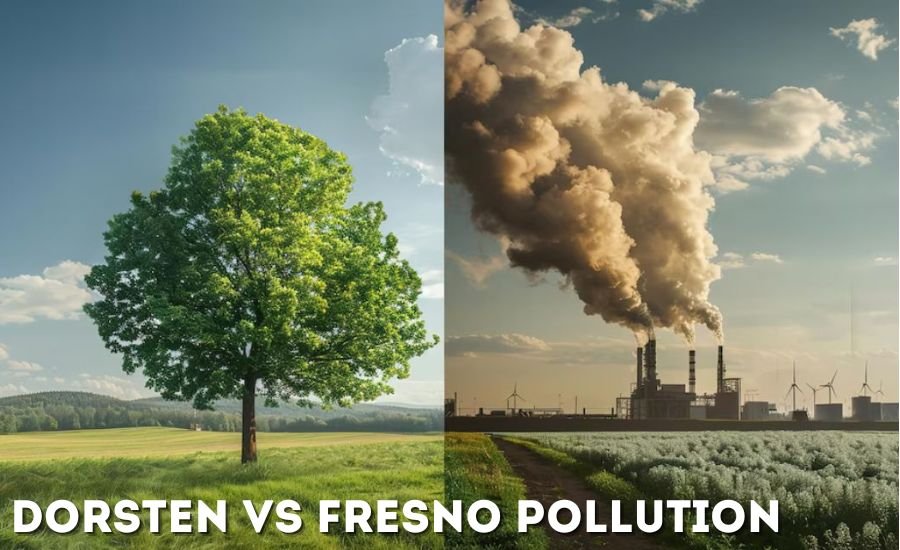Dorsten vs Fresno Pollution: A Comprehensive Comparison of Environmental Challenges

Pollution is a critical concern affecting cities worldwide, with each location facing environmental challenges. Comparing pollution levels between cities can illuminate the causes, impacts, and solutions tailored to each environment. In this article, we will delve into a detailed comparison of Dorsten, a tranquil town in Germany, and Fresno, a bustling city in California, USA. Both cities differ significantly in geography, industrial activity, and government regulations, affecting their pollution levels.
We will explore how Dorsten and Fresno compare when it comes to air pollution, water contamination, land pollution, and the health impacts of these environmental issues. By analyzing the unique factors contributing to pollution in these two regions, we aim to provide a clear understanding of the ecological challenges faced by each city and identify ways to address them effectively. Let’s begin the Dorsten vs Fresno pollution comparison.
Geographic Influence on Pollution
Geography plays a significant role in determining how pollution accumulates in an area. Dorsten, located in the Ruhr region of Germany, is known for its industrial past, but in recent years, the town has embraced greener technologies. With its moderate climate and green spaces, pollution is manageable. The city benefits from frequent rainfall, which helps wash away pollutants from the air.
Fresno, on the other hand, faces a more difficult battle. Nestled in the San Joaquin Valley, Fresno’s geographic location traps air pollutants due to the bowl-like shape of the valley. The hot, dry climate and frequent wildfires make pollution control even harder. Smog, particulate matter, and agricultural dust accumulate, especially in the summer, leading to significant pollution concerns.
Air Pollution: Comparing Dorsten and Fresno
Air pollution is one of the most visible and harmful environmental issues affecting Dorsten and Fresno. However, the sources and intensity of the pollution in these two cities are vastly different.
Air Quality in Dorsten
In Dorsten, the air quality is relatively good, thanks to strict European Union regulations that limit emissions from factories and vehicles. The town has also invested in renewable energy, reducing the reliance on fossil fuels and reducing pollution. While Dorsten does experience some air pollution from nearby factories, it is far less severe than in larger industrial cities.
Particulate matter (PM2.5 and PM10) levels in Dorsten are well below the EU safety limits, ensuring that residents are less likely to suffer from air pollution-related health problems like asthma or bronchitis. The shift toward green energy, such as wind and solar power, further helps to keep Dorsten’s air clean.
Air Quality in Fresno
Fresno, however, struggles with some of the worst air pollution in the United States. The city’s air quality is often compromised by agricultural activities, vehicle emissions, and industrial operations. During the summer, ozone levels skyrocket due to the heat, causing Fresno to rank poorly in air quality assessments.
Fresno’s geography, with its valley trapping pollution, exacerbates the problem. Wildfires, a growing concern in California, also contribute to poor air quality, releasing large amounts of particulate matter into the atmosphere. This has led to increased cases of respiratory issues such as asthma and chronic bronchitis among Fresno residents.
Comparing air pollution in Dorsten vs Fresno highlights how geography and industrial activities can lead to vastly different air quality outcomes.
Water Pollution: A Tale of Two Cities
Water pollution is another critical aspect of the Dorsten vs Fresno pollution comparison. Both cities face water contamination issues, but the sources and severity of the pollution vary greatly.
Water Pollution in Dorsten
In Dorsten, water pollution is mainly caused by agricultural runoff. Farmers use fertilizers and pesticides that can find their way into rivers and lakes, contaminating the water. However, Germany has strong water management regulations that limit the extent of this pollution. Regular monitoring and strict wastewater treatment processes ensure the water remains safe for drinking and agricultural use.
Dorsten’s residents are also actively involved in preserving water quality. Many households have adopted water-saving technologies, and local industries must treat their wastewater before releasing it into the environment.
Water Pollution in Fresno
Fresno, by contrast, faces more significant water pollution challenges. Agricultural runoff is a primary source of water contamination, with fertilizers and pesticides seeping into local rivers, lakes, and groundwater. The San Joaquin Valley, where Fresno is located, is one of the most productive agricultural regions in the world, but this comes at the cost of water quality.
Groundwater depletion is another issue in Fresno, especially during periods of drought. With less water, pollutants become more concentrated, threatening drinking water supplies and the environment. Efforts are being made to improve water treatment facilities, but Fresno still faces significant hurdles in managing its water pollution problem.
Land Pollution: Dorsten’s Efficient Waste Management vs Fresno’s Growing Landfills
Land pollution is often overlooked in pollution discussions, but it plays a crucial role in the environment’s overall health. In the Dorsten vs Fresno pollution comparison, land pollution presents yet another contrast between the two cities.
Land Pollution in Dorsten
Germany is known for its excellent recycling programs, and Dorsten is no exception. The town has an efficient waste management system that reduces the amount of waste sent to landfills. Residents are encouraged to separate their waste into recyclable and compostable materials, and the government has strict regulations to prevent land contamination.
This proactive approach to waste management has helped Dorsten maintain a clean environment with little to no land pollution. The town also benefits from its green spaces, which act as natural filters for pollutants in the soil.
Land Pollution in Fresno
Fresno, on the other hand, faces significant land pollution issues. The city’s growing population and industrial activities have led to an increase in waste generation. Fresno’s landfills are rapidly filling up, and managing this waste has become a critical challenge. Harmful chemicals from landfills can seep into the soil and potentially contaminate water sources.
While Fresno has recycling programs, they are not as widely adopted as those in Germany. As a result, much of the city’s waste still ends up in landfills, contributing to land pollution.
Health Impacts of Pollution: A Comparative Study
The health impacts of pollution are a significant concern for Dorsten and Fresno residents. Poor air and water quality can lead to various health problems, from respiratory issues to cardiovascular diseases.
In Dorsten, the relatively clean air and well-regulated water systems mean that residents are less likely to suffer from pollution-related health problems. However, the town’s proximity to industrial areas means air quality can sometimes dip, leading to temporary health risks.
On the other hand, Fresno has a much higher rate of pollution-related health issues. The city’s poor air quality, particularly during wildfire season, has led to increased cases of asthma, chronic obstructive pulmonary disease (COPD), and heart disease. Vulnerable populations, such as children and older people, are especially at risk.
Government Initiatives: Combating Pollution in Dorsten and Fresno

Both Dorsten and Fresno have implemented government initiatives to reduce pollution, but the effectiveness of these efforts varies.
Government Actions in Dorsten
Dorsten benefits from Germany’s strict environmental regulations, which are enforced at both the local and national levels. The country’s focus on renewable energy has helped reduce emissions, and Dorsten’s residents are encouraged to use public transportation, recycle, and conserve water.
The German government also invests in green technologies, such as wind and solar power, which further help reduce pollution levels. These initiatives have made Dorsten a leader in environmental sustainability.
Government Actions in Fresno
Fresno has tried to address its pollution problems, but the city faces significant challenges. California’s environmental regulations are some of the strictest in the United States, but Fresno’s unique geographic and industrial circumstances make it challenging to control pollution. The state has introduced measures to reduce vehicle emissions and promote renewable energy, but Fresno’s sizeable agricultural sector continues to be a significant source of pollution.
The city is also investing in new water treatment facilities and waste management systems, but it will take time for these efforts to show significant results.
Conclusion
In the battle of Dorsten vs Fresno pollution, it’s clear that both cities face their own unique challenges. Dorsten, with its smaller population and strict environmental regulations, enjoys cleaner air, better water management, and less land pollution. On the other hand, Fresno struggles with poor air quality, water contamination, and growing landfills due to its larger population, industrial activities, and geographic location.
While Dorsten serves as a model for sustainable environmental practices, Fresno’s fight against pollution is far from over. The city is making strides toward a cleaner future, but it will take continued effort from both the government and residents to overcome its pollution challenges.
By learning from Dorsten’s proactive approach to pollution control, Fresno can take steps toward a healthier, more sustainable environment for future generations.
FAQs
Q: What causes air pollution in Fresno?
A: Fresno’s air pollution is primarily caused by vehicle emissions, industrial activities, agricultural dust, and wildfires.
Q: How does Dorsten manage its water pollution?
A: Dorsten controls water pollution through strict regulations, regular monitoring, and advanced wastewater treatment systems.
Q: Why is Fresno’s air quality worse than Dorsten’s?
A: Fresno’s location in a valley traps pollutants, and the city faces challenges from heavy traffic, agricultural activities, and wildfires.
Q: What measures does Dorsten take to reduce air pollution?
A: Dorsten focuses on using renewable energy, promoting public transportation, and following strict EU environmental regulations.
Q: How does Fresno handle its land pollution?
A: Fresno faces challenges with large landfills, but the city is working on increasing recycling and finding better waste management solutions.
Q: What health problems are linked to pollution in Fresno?
A: Fresno’s poor air quality leads to respiratory issues like asthma and bronchitis, as well as increased risks of heart disease.
Q: How do wildfires affect Fresno’s pollution levels?
A: Wildfires significantly worsen Fresno’s air quality by increasing particulate matter and toxic pollutants in the air.
Read Next: Skrawer-Wayne-Cartoon-Book

Specializing in insightful and engaging articles across a range of topics. With a keen eye for detail and a passion for delivering high-quality information, Mary helps readers stay informed with the latest trends and updates


